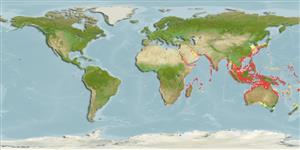分类 / Names
俗名 | 同种异名 | Catalog of Fishes(属, 种) | ITIS | CoL | WoRMS | Cloffa
Teleostei >
Scombriformes (Mackerels) >
Scombridae (Mackerels, tunas, bonitos) > Scombrinae
Etymology: Scomberomorus: Latin, scomber = mackerel + Greek, moros = silly, stupid (Ref. 45335).
Eponymy: Dr Philibert Commerson (1727–1773) was known as ‘doctor, botanist and naturalist of the King’. [...] (Ref. 128868), visit book page.
More on author: Lacepède.
Environment: milieu / climate zone / depth range / distribution range
生态学
海洋; 海洋洄游的 (Ref. 51243); 深度上下限 10 - 70 m (Ref. 12260). 熱帶; 39°N - 41°S, 7°W - 170°W (Ref. 54880)
Indo-West Pacific: Red Sea and South Africa to Southeast Asia, north to China and Japan and south to southeast Australia, and to Fiji (Ref. 6390). Immigrant to the eastern Mediterranean Sea by way of the Suez Canal. Southeast Atlantic: St. Helena.
印度-西太平洋: 紅海與南非至東南亞, 北至中國與日本而且南至澳洲東南部 , 與到斐濟。 (參考文獻 6390) 移居到地中海東部經由蘇伊士運河。 東南大西洋: 聖赫勒拿島。
Length at first maturity / 大小 / 重量 / 年龄
Maturity: Lm 75.2, range 55 - 82 cm
Max length : 240 cm FL 雄鱼/尚未辨别雌雄; (Ref. 5765); common length : 120 cm TL 雄鱼/尚未辨别雌雄; (Ref. 5450); 最大体重: 70.0 kg (Ref. 5765); 最大年龄: 22 年 (Ref. 50580)
背棘 (总数) : 15 - 18; 背的软条 (总数) : 15 - 20; 臀棘: 0; 臀鳍软条: 16 - 21; 脊椎骨: 42 - 46. This species is distinguished by the following characters: body elongate (depth 4.8-5.6 in SL), moderately strongly compressed; upper jaw reaching to posterior margin of eye or slightly beyond; teeth in jaws strong and compressed; gill rakers of first gill arch 0-2 on upper limb and 1-8 on lower limb, total 1-8; 2 dorsal fins, D1 XV-XVIII and D2 15-20, followed by 8-11 finlets; anal fin originating below midpoint of second dorsal fin, with 16-21 soft rays, followed by 7-12 finlets; lateral line abruptly bent downward below end of second dorsal fin. Colour of back iridescent blue-grey, sides silver with bluish reflections, marked with numerous thin, wavy vertical bands; number of bars increases from as few as 20 in a 40 cm specimen to as many as 65 at 150 cm; juveniles frequently spotted (Ref. 9684, 90102).
腹鳍间的突起小而两裂的。 泳鳔不存在。 侧线突然地弯曲向下的在第二背鳍鳍的末端之下。 肠道有 2 摺层与 3 肢翼。 在躯干上的纵带有时断裂成斑点腹数目 40-50 当成鱼时, 而且少于 20 在稚鱼中。 在身体上稚鱼有大的椭圆形的深色斑点; 第一背鳍的中央三个白色,其它的鳍黑色.(参考文献 11228)
A pelagic fish, inhabiting near edge of continental shelf to shallow coastal waters, often of low salinity and high turbidity (Ref. 30199, 48637); also found in drop-offs, and shallow or gently sloping reef and lagoon waters (Ref. 1602, 48637). Feed primarily on small fishes like anchovies, clupeids, carangids, also squids and penaeoid shrimps. Usually hunts solitary and often swim in shallow water along coastal slopes (Ref. 48637). Eggs and larvae are pelagic (Ref. 6769). Caught mainly with drift gill nets, bamboo stake traps, midwater trawls, and by trolling. Marketed mainly fresh; also dried-salted; commonly made into fish balls (Ref. 9684), frozen, smoked, and canned (Ref. 9987). A lipid-soluble toxin, similar to ciguatoxin has been found in the flesh of specimens caught on the east coast of Queensland, Australia. Known to undertake lengthy long-shore migrations, but permanent resident populations also seem to exist.
从大陆棚的近边缘到沿岸浅水区分布了, 时常低盐度与高混浊度.(参考文献 30199,48637) 也发现于海峭壁 , 与水浅或缓斜坡的礁与舄湖水域。 (参考文献 1602,48637) 通常沿着海岸的斜坡狩猎独居性而且时常在浅水区中游泳。 (参考文献 48637) 已知进行长途的沿岸回游, 但是永久的定居族群也似乎存在。 发现于小群鱼群了。 (参考文献 9684) 主要捕食像鳀鱼,鲱鱼,鲹,也捕食乌贼与对虾的小鱼。 一个脂质-溶解的毒素, 类似 ciguatoxin 已经被发现于在澳洲的昆士兰省的東海岸上面捕獲的標本的肉。 在市場上銷售生鮮地了, 被凍結,煙燻, 與罐裝的乾燥鹽醃 (參考文獻 9684);(參考文獻 9987) 通常製成了魚丸。
Life cycle and mating behavior
成熟度 | 繁殖 | 产卵场 | 卵 | 孕卵数 | 仔鱼
Depending on temperature regime, the spawning season may be more or less extended.
In Australian waters, each female spawns several times over the season, about 2 to 6 days apart (Ref. 30196), depending on the locality. Spanish mackerel spawn off the reef slopes and edges, and they form spawning aggregations in specific areas (Ref. 6390).印度-西太平洋: 紅海與南非至東南亞, 北至中國與日本而且南至澳洲東南部 , 與到斐濟。 (參考文獻 6390) 移居到地中海東部經由蘇伊士運河。 東南大西洋: 聖赫勒拿島。
Collette, B.B. and C.E. Nauen, 1983. FAO Species Catalogue. Vol. 2. Scombrids of the world. An annotated and illustrated catalogue of tunas, mackerels, bonitos and related species known to date. Rome: FAO. FAO Fish. Synop. 125(2):137 p. (Ref. 168)
世界自然保护联盟红皮书 (Ref. 130435: Version 2024-2)
临近濒危 (NT) (A2bd); Date assessed: 10 November 2022
人类利用
渔业: 高经济性; 游钓鱼种: 是的
工具
特别资料
下载 XML
网络资源
Estimates based on models
Preferred temperature (Ref.
123201): 22.8 - 29, mean 28 °C (based on 1324 cells).
Phylogenetic diversity index (Ref.
82804): PD
50 = 0.5000 [Uniqueness, from 0.5 = low to 2.0 = high].
Bayesian length-weight: a=0.00661 (0.00586 - 0.00745), b=3.00 (2.97 - 3.03), in cm total length, based on LWR estimates for this species (Ref.
93245).
营养阶层 (Ref.
69278): 4.5 ±0.4 se; based on diet studies.
Generation time: 3.6 (2.2 - 5.2) years. Estimated as median ln(3)/K based on 32
growth studies.
回复力 (Ref.
120179): 中等的, 族群倍增时间最少 1.4 - 4.4年 (K=0.12-0.21; tm=2-3; tmax=14; Fec=590,000).
Prior r = 0.98, 95% CL = 0.65 - 1.47, Based on 1 full stock assessment.
Fishing Vulnerability (Ref.
59153): Moderate to high vulnerability (52 of 100).
Climate Vulnerability (Ref.
125649): High to very high vulnerability (75 of 100).
Nutrients (Ref.
124155): Calcium = 19.6 [8.5, 74.3] mg/100g; Iron = 0.719 [0.310, 1.705] mg/100g; Protein = 20.9 [19.6, 22.1] %; Omega3 = 0.222 [0.131, 0.380] g/100g; Selenium = 72.5 [25.5, 222.5] μg/100g; VitaminA = 13.6 [3.2, 60.0] μg/100g; Zinc = 0.508 [0.338, 0.818] mg/100g (wet weight); based on
nutrient studies.
